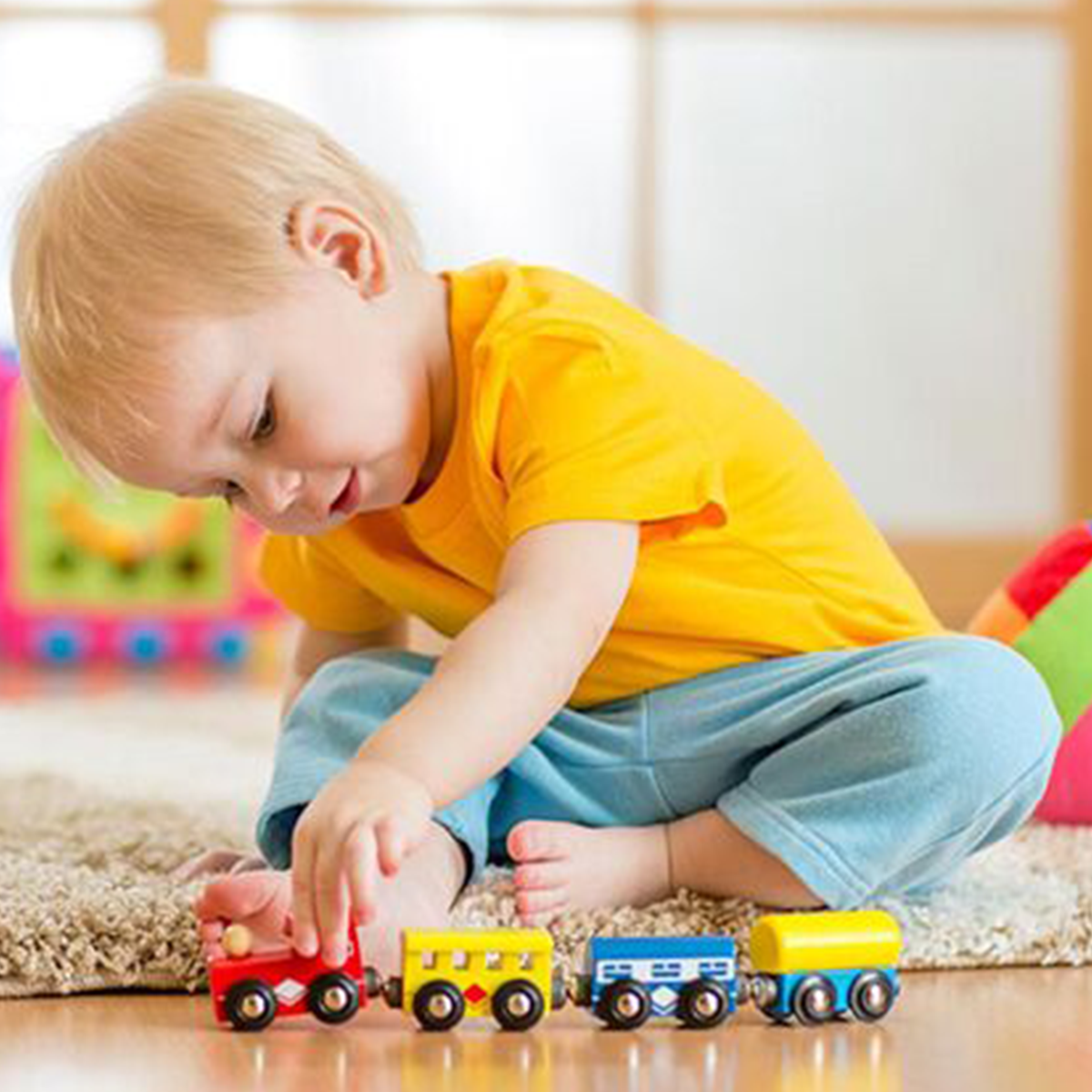At 2.5 years old, the child holds a pencil with their fingers and can scribble, build a bridge with blocks, and kick a ball with their foot.
In the same year, due to increased muscular strength, the child watches carefully with their eyes while drawing to ensure the line does not go beyond the designated area.
At this age, the child can stack similar objects, and we can also ask them to place washed items such as spoons, forks, and other utensils onto their matching spots in the kitchen shelves.
Between the ages of 2 and 2.5 years, the child begins to engage in imaginative play.
In the same year, the child can place blocks in a row on the floor to make a train.
At two and a half years old, the child can sit on a tricycle, steer it by turning the handlebars with their hands, but is not yet able to pedal.
Between the ages of 2 and 2.5 years, boys and girls usually share similar toys. However, from this point on, grandparents tend to give dolls to girls and toy cars to boys. At this age, boys often choose fire trucks and airplanes, while girls look for dolls and large wooden beads to string together.
Between 2.5 and 3 years of age, imitation of parents becomes a favorite activity for children. Boys enjoy pretending to drive cars, while girls show interest in cooking and housekeeping.
This age is also the stage of imagination and role-playing games. A girl may play doctor or nurse using a toy medical kit—giving her doll an injection, checking its temperature, or acting as a shopkeeper.
At this age, both girls and boys enjoy building with Lego blocks and love drawing. Dolls are the most valued toys for girls, while cars are the most treasured toys for boys.
At 2.5 years old, the child climbs stairs independently and holds onto the railing or wall when going down. Toys that can be taken apart and divided into various pieces, such as trains, cars, wooden blocks, Lego, wooden cubes, different puzzles, and similar items, especially if colorful, are favored by the child.
In the third year of life, considering the increasing skills the child acquires, toys appropriate to their abilities should be provided; toys such as trains, cars, building blocks, and dolls that they can change clothes for and feed.
At 3 years old, the child holds a pencil like an adult and can cut well with scissors. They pick up objects using their thumb or middle finger and thumb. They roll and fold paper, imitate drawing a person, draw circles, and can combine vertical and horizontal lines.
At the age of 3, provide suitable opportunities for entertaining games both inside and outside the house for the child, such as climbing, running, walking slowly, and jumping. Provide toys that the child can take apart (like beads). Of course, the beads should be large enough not to be swallowed. Also, offer opportunities for filling and emptying containers with sand, water, rice, and legumes. Prepare crayons, chalk, paint, and paper for drawing and writing.
Try to enhance the child’s language skills and encourage them to talk with you. Use pronouns such as “I,” “me,” “you,” “they,” and “we” during conversations and teach the child to use these words. Talk with the child about pictures and ask them to point to objects or their names. Always use the correct names for objects.
At 3 years old, the child shows interest in pretend play. Stand in front of the child and ask them to imitate everything you do. Provide dolls, a small cart, doll beds, toy phones for conversation, and pretend play activities for the child.
At this age, the child is interested in balance, size, and ways of stacking blocks. For a 3-year-old child, a block can represent a train, a doll, or a building.
A 3-year-old child is able to arrange colored balls in the sequence red, yellow-red, yellow. He/she classifies colors and shapes. For example, the child sorts buttons by color and size and can name up to three colors. He/she can focus on a game for half an hour and feels satisfied and happy upon achieving the goal.
Three-year-old children usually place blocks horizontally and rarely initiate building something on their own at this age. A 3-year-old child begins to create simple and definite shapes while playing with LEGO blocks.
Around the age of 3, a child likes to play with materials that they can hit, squeeze, tear apart, and stack. Crushing and squeezing materials provides the child with comfort. Playing with clay and dough meets this need and helps the child feel calm during play.
During this period, drawing tools are very suitable for playing. The child is interested in colored pencils and markers. Wooden pieces that can be threaded with string or rope and lined up also entertain the child. In parks, swings, seesaws, slides, and ladders can be used while observing safety precautions.
At 3 years old, the child is able to walk and their hands have the ability to perform more complex movements. Therefore, toys such as a small plastic tricycle, cart, truck, and ball can be provided. Mobiles and pinwheels are among the play items that children at 3 years old can help make. Puzzles with fewer pieces (four to five) are suitable for younger children aged two to three. At 3 years old, the child can cut paper with scissors.
When playing with two or three 3-year-old children who are playing with a ball, we as adults can join in and whenever the ball comes towards us, we catch it and throw it to one of the children. At this age, most children enjoy these kinds of games.
At the age of 2½ to 3 years, the child mostly plays alongside other children, but does not engage in true cooperative play with them.
Three-year-old children begin their first attempts at cooperative play with 2 to 3 playmates. The child participates in groups of three in games and other children’s activities and gradually becomes ready to understand the rights of others. At this age, they fight more than ever over toys. Group play, which at this age involves at most 3 children, is unstable and quickly breaks up because children at this age can only play with one other child at a time.
A 3-year-old child enjoys balancing, asking various questions, and playing with boxes, bricks, and boards, as well as jumping rope. They can also ride and pedal a tricycle.
Three-year-old children begin their first attempts at cooperative play with 2 to 3 playmates. The child participates in groups of three in games and other children’s activities and gradually becomes ready to understand the rights of others. At this age, they fight more than ever over toys. Group play, which at this age involves at most 3 children, is unstable and quickly breaks up because children at this age can only play with one other child at a time.
media: پرتال جامع علوم انسانی






